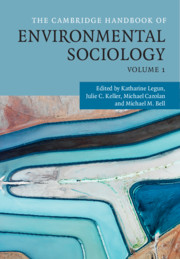Book contents
- The Cambridge Handbook of Environmental Sociology Volume 1
- The Cambridge Handbook of Environmental Sociology
- Copyright page
- Contents
- Figures
- Tables
- Contributors
- Foreword
- Introduction
- Part I Theory in Environmental Sociology
- Part II The Economy and Environmental Sociology
- Part III Culture and Environmental Sociology
- 12 Media and the Environmental Movement in a Digital Age
- 13 National Parks and (Neo)Colonialisms
- 14 Post Carbon Transition Futuring: For a Reconstructive Turn in the Environmental Social Sciences?
- 15 Outer Space and New Frontiers to Environmental Imaginations
- 16 New Territory for Environmental Sociology: Environmental Philosophy and Nature-Based Tourism
- Part IV Politics, Power, State
- Part V Social Justice
- Index
- References
16 - New Territory for Environmental Sociology: Environmental Philosophy and Nature-Based Tourism
from Part III - Culture and Environmental Sociology
Published online by Cambridge University Press: 05 November 2020
- The Cambridge Handbook of Environmental Sociology Volume 1
- The Cambridge Handbook of Environmental Sociology
- Copyright page
- Contents
- Figures
- Tables
- Contributors
- Foreword
- Introduction
- Part I Theory in Environmental Sociology
- Part II The Economy and Environmental Sociology
- Part III Culture and Environmental Sociology
- 12 Media and the Environmental Movement in a Digital Age
- 13 National Parks and (Neo)Colonialisms
- 14 Post Carbon Transition Futuring: For a Reconstructive Turn in the Environmental Social Sciences?
- 15 Outer Space and New Frontiers to Environmental Imaginations
- 16 New Territory for Environmental Sociology: Environmental Philosophy and Nature-Based Tourism
- Part IV Politics, Power, State
- Part V Social Justice
- Index
- References
Summary
Environmental sociology studies societal–environmental relations and interactions. With emphasis given to the inseparability of humanity and nature, this chapter adopts an interdisciplinary approach to environmental sociology in order to link environmental philosophy with nature-based tourism. Environmental philosophy studies philosophical issues pertaining to the human–nature relationship, yet few studies address environmental philosophy in relation to tourism. Here we argue that the application of environmental philosophy to nature-based tourism offers potential insights that are important to the interests of environmental sociologists. Using a theoretical framework of environmental philosophy, we carefully explore how the development of mainland ecosanctuaries in New Zealand is linked with theories of environmental ethics, aesthetics and metaphysics. Under the umbrella of environmental sociology, our analysis identifies challenges and opportunities related to how nature-based tourism operators communicate their environmental understandings and conservation practices to tourists shaped by distinct social norms and value systems. It is argued that the ecocentrism-based environmental philosophy and ecological restoration of mainland ecosanctuaries in New Zealand pose a great challenge to the experiences and interests of international tourists from a wide range of diverse social and environmental ‘home’ contexts.
Keywords
- Type
- Chapter
- Information
- The Cambridge Handbook of Environmental Sociology , pp. 262 - 282Publisher: Cambridge University PressPrint publication year: 2020



